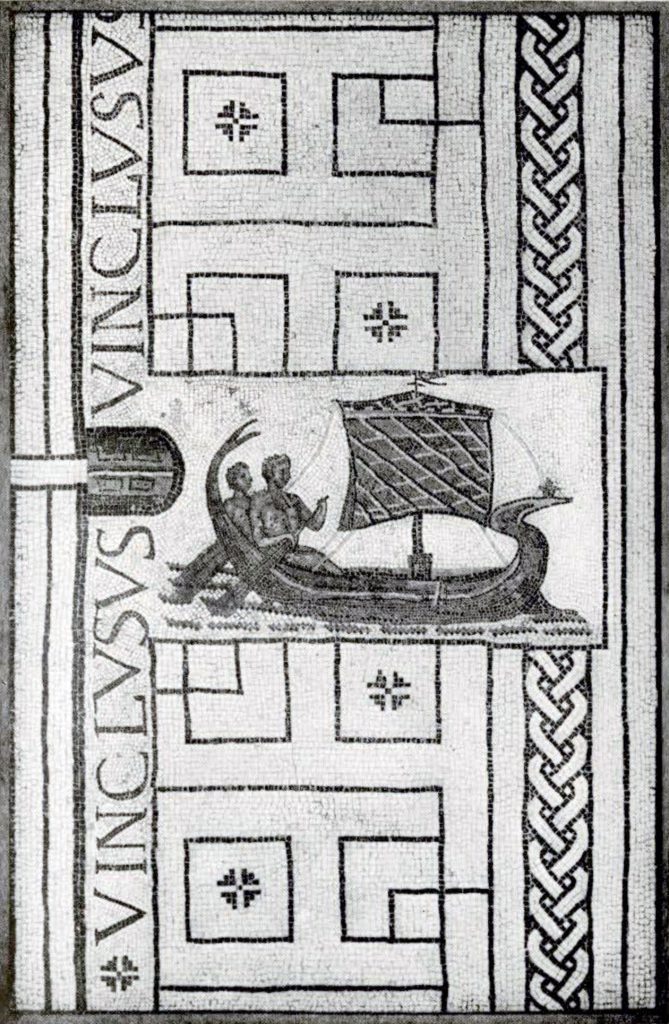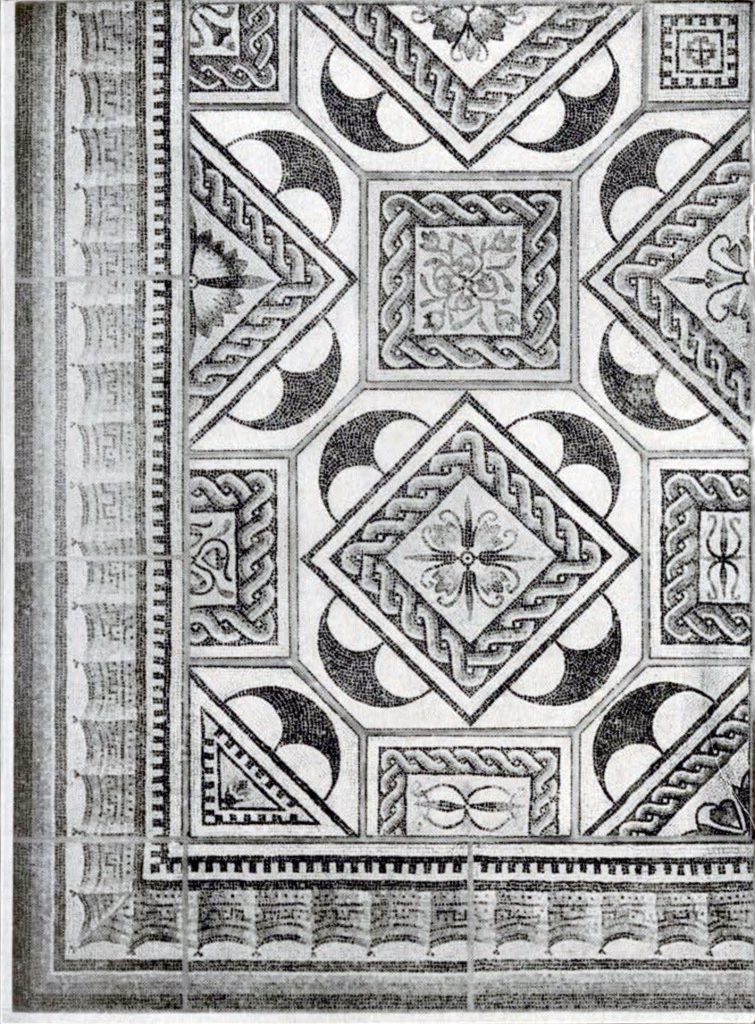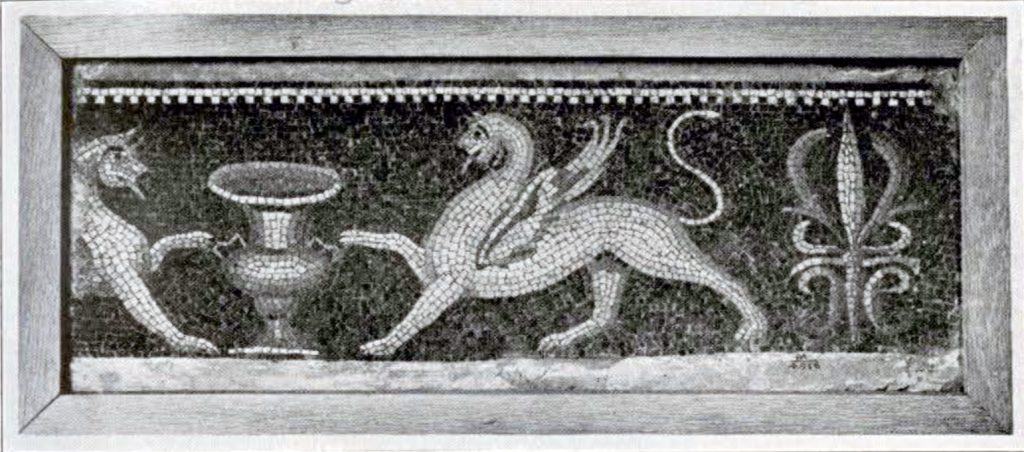In 1904 Mrs. Dillwyn Parrish of London presented to the Museum in memory of her husband, the late Mr. Dillwyn Parrish, five examples of ancient mosaic pavement of Roman times. Of these the two most important specimens from the point of view of size come from Carthage, while the other three, smaller, to be sure, but nevertheless charming examples, are said to come from Rome.
Let us look at the Carthaginian mosaics first. They are to be found on the way to the new Rotunda, on the walls of the vestibule to the right and left as you enter. These mosaics belong, as has been said, to the Roman city of Carthage.
One ordinarily considers that the history of Carthage stopped with the Punic Wars and the sack and destruction of the city in 146 B.C., and we forget that the city was rebuilt as a Roman colony. 146 B.C. is an important date in Roman history. In that year Corinth fell in the East, and the Greek world fell under Roman sway, and Carthage in the West was captured, thus marking the subjugation of Rome’s greatest and bitterest enemy. Both Corinth and Carthage were then laid under a curse, and became unoccupied, uninhabited, and barren. Carthage was even more completely destroyed than was Corinth; for underneath the Roman city the French excavators have found a thick layer of ashes, practically all that there is left of the city of Hannibal.

Museum Object Number: MS4012
Image Number: 3348
On the other hand, Carthage was reoccupied, or rather, attempts were made to rebuild it, soon after its fall. As early as 122 B.C., the Senate decided to plant a Roman colony there; but this first colony did not prosper, and fifty years later, when Marius, fleeing from the persecution of Sulla, came there, he found the city practically uninhabited. It remained for Julius Caesar to found the first successful colony, which he did in 46 B.C., just a century after its fall. In that year, too, he started a Roman colony in Corinth; so that the two cities, destroyed in the same year, were rebuilt and repopulated in the same year.
From this time on Carthage prospered. Furthered by the patronage of Augustus, it became in 14 B.C. the seat of the proconsul of Africa, taking the place of Utica, which up to that time had enjoyed that distinction. From that time on, like Corinth in the East, which had become the capital of the province of Achaea, Carthage became a center of luxury and wealth, and increased greatly in population. But it is, through the greater part of the Empire, one of those happy places which have no history; although it took part in two uprisings, in 68 A.D. and in 265 A.D. The most important event in its history politically or economically seems to have been a great fire, in the reign of Antoninus Pius, which destroyed the district around the Forum, or the business section of the city.
But the principal importance of Carthage in Imperial times lies in its connection with Christianity. It accepted the new faith with enthusiasm and great eagerness at an early stage in the history of the Church. At the end of the second century of our era it was made a bishopric and was the see of many famous bishops, the greatest of whom is Tertullian, who held the episcopal seat from 202 till his death in 218, and who, besides being an ecclesiastic, was also an author of merit and in fact the creator of Christian Latin literature. His successor, St. Cyprian (248-257), is also a famous character in the history of the early Church and the first African bishop to be made a martyr. Between 251 and 424 eleven synods of the Church were held at Carthage, the most important one being in 411, when the “Donatist” heresy was suppressed through the influence of St. Augustine.
Finally in 429 the peace of the city was disturbed by the invasion of the Vandals, headed by their famous king, Genseric. Ten years later he laid siege to Carthage, which, being peaceful and defenseless, fell without a blow, and was sacked by the barbarians.
At the time of its capture, Carthage was a large, prosperous city of 500,000 inhabitants; but after this, under the Vandals, it became nothing more than a station for piratical craft. In 533 the Vandals lost it to the Byzantines under Belisarius; in 697 they in turn surrendered it to the Saracens, who destroyed the city in the following year. From then on it appears only once in the History of the Middle Ages, when St. Louis, King of France, died there in 1270 when on a Crusade.
It is no wonder that a city so wealthy as Carthage must have been in Roman Imperial times should have left us such finds as these mosaics. Nor are these the only ones from there; the British Museum’s choicest mosaics are from Carthage, and so are many of the Louvre’s best specimens.
Before we take up the difficult matter of dating these examples, let us take up the matter of the technique. There are four kinds of ancient mosaics, all of which flourish side by side, though some are earlier in origin than others.
- OPUS TESSELLATUM.—Cubes of marble or stone regularly disposed in simple patterns. Largely used for pavements.
- OPUS VERMICULATUM.—Cubes (not always regularly shaped) generally of colored marble or more precious materials when available, disposed so as to obtain a pictorial effect. With this technique the whole art of mosaic is concerned.
- OPUS MUSIVUM.—Applied to the decoration of walls or vaulted ceilings; cubes of glass or enamel were used, the glass being made opaque and colored, then cast into flat slabs and broken into small cubes.
- OPUS SECTILE.—A species of marqueterie in marble or other colored materials, used to produce pictures and patterns. From this technique there developed in the late Empire
- 4a. OPUS ALEXANDRINUM.—A late form of Opus Sectile, limiting its materials principally to red and green porphyry. The theory advanced by the ancient biographer of the emperor Alexander Severus (Hist. Aug., chapter 25, section 7) that this emperor invented the technique and that therefore it was named for him is surely incorrect, and a false etymology; for it was undoubtedly invented and developed at Alexandria, and perhaps took its first start in Rome during the reign of this emperor.
The two mosaics from Carthage that we are discussing are both of the second technique mentioned, the Opus Vermiculatum, and are very good examples of this kind of work. This form of mosaic seems to have been invented by the ancient Egyptians, and its beginnings go back to a very remote antiquity. First used for jewelry and minor objects, like the mosaic ornaments sold in Rome and Venice today, it began to be used for more ambitious purposes in the Ptolemaic period, when the progress in the manufacture of glass and the opening of quarries of colored marbles made these materials cheaper and more common; and it is from this period that we first begin to hear of mosaic pavements. From Egypt the art was introduced throughout the Eastern Mediterranean, and found especial favor in the Greek world. To this period, or a little later, about the end of the second century B.C., belong the famous and beautiful mosaic pavements still in situ at Delos, in various private houses discovered by the French archaeologists, especially the House of the Trident.

Museum Object Number: MS4015
Image Number: 3347
These mosaics from Carthage, however, cannot, of course, be dated earlier than the end of the first century B.C., from the point of view of history, and a study of their style leads the student to put them at a much later date. From this point of view they cannot be earlier than the first century of our era, but this was a period of the greatest excellence in artistic as well as technical skill. The first one which will be examined is the one illustrated by Fig. 12, as it seems to be of somewhat earlier date than the other one from Carthage. The illustration will give the reader some idea of the artistic feeling and immense technical skill of the maker. Especially noticeable is the wonderful treatment of the flesh of the two men in the boat. The play of light and shade on the skin is so excellently handled that their bodies seem to gleam as if they were anointed with oil. It is a feat to show this not by means of paint or by a wide choice of color, but merely by means of small cubes of marble of a comparatively restricted number of shades. Another point in assigning this to a very good period is the feeling of reserve space given to the student. There is no overcrowding of the space, but the design is simple and restrained. This, and the general excellence of execution, combine to make us put this mosaic at a very good period, probably in the middle of the first century of our era, when the artists of the mosaic art combined artistic imagination with great technical skill. Later we shall see that technical skill drove out imagination and that the later mosaics are very uninteresting in subject as compared with the older ones, but are of supreme importance for their exhibition of the different tricks of technique known to the makers. This mosaic bears, twice repeated, the curious inscription V I N C L V S V S. The meaning of this inscription is not at all clear. The illustration shows that it is thought of as a complete word, and that nothing is lost from it. There is no such word in ordinary use in the Latin language, and it becomes a problem as to what its meaning may be. A solution of this would be extremely welcome, as it might throw some light upon the life of the inhabitants of Roman Carthage.*
Our second pavement (Fig. 13) from Carthage, however, in the opinion of the writer, should be put at a later date than the first. It is still in a good period, before all imagination had departed and given place to exhibitions of technical skill, but it shows the tendency to turn mosaic from a pictorial to a decorative art. In this specimen the patterns are all purely of a decorative nature; but there is a great deal of boldness of imagination and conception in the patterns employed. In fact, it is a very beautiful pavement, and though the space is somewhat crowded, the details in no way force themselves upon the critical observer, but blend to make each pattern a perfect whole, harmonious in relation to the other designs around it. For this reason it seems best to put this mosaic as a work of the end of the first or beginning of the second century A.D.
The other three mosaics that formed Mr. Parrish’s gift to the Museum will be found in Alcove B in the room on the right of the stairs. This is the room where are also to be found the sculptures, Roman glass, and reproductions of Cretan and Mycenaean objects. These three mosaics, which, although small, are nevertheless important examples, are said to have come from Rome.
The first one to be considered here is the charming one with the picture of a duck. This is probably the earliest of the five mosaics of the collection, and may date before the Christian era. This exquisite fragment has much in common with some of the mosaics found in the House of the Faun at Pompeii, which is dated in the second century B.C. according to the great German scholar August Mau, in his book on Pompeii published in 1908, in the second century B. C. Modern investigations carried on since that time make scholars incline to make this house a first century rather than a second century dwelling; but even then it is early enough to be very important in the history of mosaics.
In one of the wings off the main atrium of this house were found mosaics showing ducks. These are said closely to resemble the duck in the Museum’s mosaic. So it seems safe to say that in this charming fragment we have an example of work of at least the first century B.C., or perhaps the second. In this mosaic, as in those in the House of the Faun, we find a most ingenious use of glass in combination with colored stone to show, in this case, the neck and bill of the bird. The naturalism and effectiveness of the composition show a certain amount of Greek influence and put it in about the best period of all. It, too, is of Opus Vermiculatum.

Museum Object Number: MS4016
Image Number: 3343
The next one to consider is also of Opus Vermiculatum, but is of considerably later date. It is the one showing two griffins facing an urn (Fig. 14). Of one of the griffins, only the head and fore-legs are preserved. Here the mosaic art has become absolutely decorative, and shows it in attempting a more or less pictorial design; for it treats it in a purely decorative manner. This is the stiff, conventional, unimaginative work of the second century A.D. The griffins are in conventional decorative postures, reminding one of an heraldic device. On the other hand, the lack of imagination is in some degree made up by the great technical skill shown in the treatment of the griffins. Color is obtained by the use of cubes of opaque glass applied very judiciously in the wings and tongues of the two beasts; and not only are they done minutely, but the whole mosaic is made with the greatest skill and precision. But we miss here the naturalness and simplicity of the duck.
The third and last specimen is a bit of Opus Alexandrinum. As has been said earlier in this essay, this technique was introduced in the late Empire, and rapidly became popular. This is an excellent example, with its alternating squares of red and green porphyry. The author was told on very good authority that the white designs were not employed in this technique until Christian times, so that this mosaic should probably be considered Early Christian rather than Roman, and dated as such. This would put it in the third or fourth centuries of our era. It is especially hard to date this fragment accurately, as this technique remains the same for centuries.
In conclusion, it may be of interest to say a few words as to how the Greeks and Romans manufactured their mosaics. Vitruvius begins his seventh book with instructions as to how to make a mosaic pavement, and the finds bear out his instructions, as they are made in the way he describes.
First the earth was carefully rammed down to a firm and even surface; on this was then laid a thick bed of stones, dry rubbish, and lime, from six to nine inches deep. This bed or foundation was called “rudus,” and was packed down as solidly as possible. Upon this was laid a bed of concrete, called “nucleus,” from four to six inches thick, composed of one part of lime to three of pounded brick mixed with water.
When this concrete was still soft, the design was sketched on it with a wooden or metal point, and the “tessera” or cubes of stone or glass were inserted with their smoothest end uppermost. Then lime, pounded white marble, and water were mixed to the consistency of cream, forming a very hard-setting cement, called “marmoratum.” This cement, while fluid, was poured over the marble surface, and well brushed into all the interstices between the tesserae. When the concrete and cement were both set, the surface of the pavement was rubbed down and polished.
In conclusion, the Museum is very fortunate in possessing these good examples of the Roman mosaic art, especially the large and important specimens from Carthage, where some of the most beautiful of Roman mosaics have been found, and where the artistic and technical skill of the worker in this art reached a very great height.
S. R. L.
* It has been suggested to the writer by Prof. W. B. McDaniel that this may be VINC(IMUS) LVSVS, “we win our games,” or VINC(TOR) (for Victor) LVSVS, “the winner of a game.”

